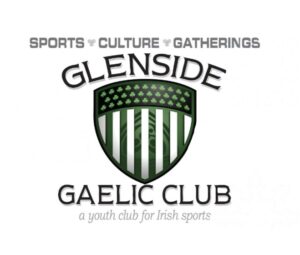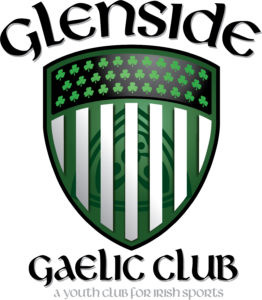About Hurling/Camogie
Hurling (for boys) and Camogie (for girls) are both bat and ball games that combine the hitting skills of baseball with the stick skills of hockey/field hockey in a high speed, high octane field sport reminiscent of lacrosse. Hurling/Camogie is an outdoor team game of ancient Gaelic origin, administered by the Gaelic Athletic Association. The game has prehistoric origins, has been played for over 3,000 years, and is thought to be the world’s fastest field team game in terms of game play. One of Ireland’s native Gaelic games, it shares a number of features with Gaelic football, such as the field and goals, number of players, and much terminology.
The object of the game is for players to use a wooden stick called a hurley to hit a small ball called a sliotar between the opponents’ goalposts either over the crossbar for one point, or under the crossbar into a net guarded by a goalkeeper for one goal, which is equivalent to three points. The sliotar can be caught in the hand and carried for not more than four steps, struck in the air, or struck on the ground with the hurley. It can be kicked or slapped with an open hand (the hand pass) for short-range passing. A player who wants to carry the ball for more than four steps has to bounce or balance the sliotar on the end of the stick and the ball can only be handled twice while in his possession.
Baiting is allowed although body-checking or shoulder-charging is illegal. No protective padding is worn by players. A plastic protective helmet with faceguard is mandatory for all age groups, including senior level, as of 2010. The game has been described as “a bastion of humility”, with player names absent from jerseys and a player’s number decided by his position on the field.
Hurling/Camogie is played throughout the world, and is popular among members of the Irish diaspora in North America, Europe, Australia, New Zealand, South Africa and Argentina. There is no professional league, so the players today are unpaid amateurs. In many parts of Ireland, it is a fixture of life. It has featured regularly in art forms such as film and literature. In 2007, Forbes magazine described the media attention and population multiplication of Thurles town ahead of one of the game’s annual provincial hurling finals as being “the rough equivalent of 30 million Americans watching a regional lacrosse game”.
Statistics of Hurling/Camogie
- A team comprises 15 players, or “hurlers”.
- The hurley is generally 79–100 cm (31–40 inches) in length.
- The ball, known as a sliotar, has a cork center and a leather cover; it is between 69 and 72 mm in diameter, and weighs between 110 and 120 g.
- The goalkeeper’s hurley usually has a base (the flattened, curved end) twice the size of other players’ hurleys to provide some advantage against the fast moving sliotar.
- A good strike with a hurley can propel the ball up to and over 150 km/h (93 mph) in speed and 110 meters (361 ft.) in distance.
- A ball hit over the bar is worth one point. A ball that is hit under the bar is called a goal and is worth three points.
- As of 2010 all players must wear a helmet, and may wear other protection such as shinguards and/or a special kind of glove called an ashguard.
Rules of Hurling/Camogie
Playing field:
Hurling is played on a pitch 135–145 m long and 80–90 m wide. The goals at each end of the field are formed by two posts, which are usually 6 m high, set 6.4 m apart, and connected 2.44 m above the ground by a crossbar. A net extending in back of the goal is attached to the crossbar and lower goal posts. The same pitch is used for Gaelic football; the GAA, which organizes both sports, decided this to facilitate dual usage. Lines are marked at 13 m, 20 m, 65 m and 45 m in Gaelic football from each end-line. Shorter pitches and smaller goals are used by under-13s and younger.
Teams:
Teams consist of between seven and fifteen players. The panel is made up of 24–30 players and five substitutions are allowed per game. No exceptions are ever made.
Ball:
The ball is called sliotar and it is a subject to strict regulations as regards its size, mass and composition.
Helmets:
Beginning on January 1, 2010 the wearing of helmets with faceguards became compulsory for hurlers at all levels. This saw senior players follow the regulations already introduced in 2009 at minor and under 21 grades. The GAA hopes to significantly reduce the number of injuries by introducing the compulsory wearing of helmets with full faceguards, both in training and matches. Hurlers of all ages, including those at nursery clubs when holding a hurley in their hand, must wear a helmet and faceguard at all times. Match officials will be obliged to stop play if any player at any level appears on the field of play without the necessary standard of equipment.
Timekeeping:
Senior inter-county matches last 70 minutes (35 minutes per half). All other matches last 60 minutes (30 minutes per half). For age groups of under-13 or lower, games may be shortened to 50 minutes. Timekeeping is at the discretion of the referee who adds on stoppage time at the end of each half.
If a knockout game finishes in a draw, a replay is played. If a replay finishes in a draw, 20 minutes extra time is played (10 minutes per half). If the game is still tied, another replay is played.
In club competitions, replays are increasingly not used due to the fixture backlogs caused. Instead, extra time is played after a draw, and if the game is still level after that it will go to a replay.
Technical fouls:
The following are considered technical fouls (“fouling the ball”):
- Picking the ball directly off the ground (instead it must be flicked up with the hurley)
- Throwing the ball (instead it must be “hand-passed”: slapped with the open hand)
- Going more than four steps with the ball in the hand (it may be carried indefinitely on the hurley though)
- Catching the ball three times in a row without it touching the ground (touching the hurley does not count)
- Putting the ball from one hand to the other
- Hand-passing a goal
- Throwing the hurley
Scoring:
Scoring is achieved by sending the sliotar (ball) between the opposition’s goal posts. The posts, which are at each end of the field, are “H” posts as in rugby football but with a net under the crossbar as in soccer. The posts are 6.4 m apart and the crossbar is 2.44 m above the ground.
If the ball goes over the crossbar, a point is scored and a white flag is raised by an umpire. If the ball goes below the crossbar, a goal, worth three points, is scored, and a green flag is raised by an umpire. The goal is guarded by a goalkeeper. Scores are recorded in the format {goal total} – {point total}. For example, the 1997 All-Ireland final finished: Clare 0–20 Tipperary 2–13. Thus Clare won by “twenty points to two thirteen” (20 to 19). 2–0 would be referred to as “two goals”, never “two zero”. 0–0 is said “no score”.
Defending:
Players may be defended but not struck by a one handed slash of the stick; exceptions are two handed jabs and strikes. Jersey-pulling, wrestling, pushing and tripping are all forbidden. There are several forms of acceptable defending, the most popular being:
- the “block”, where one player attempts to smother an opposing player’s strike by trapping the ball between his hurley and the opponent’s swinging hurl;
- the “hook”, where a player approaches another player from a rear angle and attempts to catch the opponent’s hurley with his own at the top of the swing; and
- the “side pull”, where two players running together for the sliotar will collide at the shoulders and swing together to win the tackle and “pull” (name given to swing the hurley) with extreme force.
Restarting play:
The match begins with the referee throwing the sliotar in between the four midfielders on the halfway line.
After an attacker has scored or put the ball wide of the goals, the goalkeeper may take a “puckout” from the hand at the edge of the small square. All players must be beyond the 20 m line.
After a defender has put the ball wide of the goals, an attacker may take a “65″ from the 65 m line level with where the ball went wide. It must be taken by lifting and striking. However, the ball must not be taken into the hand but struck whilst the ball is lifted.
After a player has put the ball over the sideline, the other team may take a ‘sideline cut’ at the point where the ball left the pitch. It must be taken from the ground.
After a player has committed a foul, the other team may take a ‘free’ at the point where the foul was committed. It must be taken by lifting and striking in the same style as the “65″.
After a defender has committed a foul inside the Square (large rectangle), the other team may take a “penalty” from the ground from the center of the 20 m line. Only the goalkeeper and two defenders may guard the goals. It must be taken by lifting and striking.
If many players are struggling for the ball and no side is able to capitalize or gain control of the sliotar the referee may choose to throw the ball in between two opposing players.
Officials:
A hurling/camogie match is watched over by eight officials:
- The referee
- Two linesmen
- Sideline official/standby linesman (inter-county games only)
- Four umpires (two at each end)
The referee is responsible for starting and stopping play, recording the score, awarding frees and issuing penalty cards to players after offences.
Linesmen are responsible for indicating the direction of line balls to the referee and also for conferring with the referee. The fourth official is responsible for overseeing substitutions, and also indicating the amount of stoppage time (signaled to him by the referee) and the players substituted using an electronic board. The umpires are responsible for judging the scoring. They indicate to the referee whether a shot was: wide (spread both arms), a 65 m puck (raise one arm), a point (wave white flag), or a goal (wave green flag).
Contrary to popular belief within the association, all officials are not obliged to indicate “any misdemeanors” to the referee, but are in fact only permitted to inform the referee of violent conduct they have witnessed which has occurred without the referee’s knowledge. A linesman/umpire is not permitted to inform the referee of technical fouls such as a “Third time in the hand”, where a player catches the ball for a third time in succession after soloing or an illegal pick up of the ball. Such decisions can only be made at the discretion of the referee.

